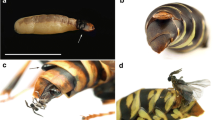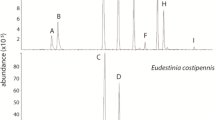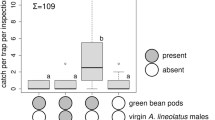Abstract
Our objective was to identify the sex pheromone of Lymantria bantaizana (Lepidoptera: Lymantriidae) whose larvae feed exclusively on walnut, Juglans spp., in China, and Japan. Coupled gas chromatographic–electroantennographic detection (GC-EAD) analyses of pheromone gland extracts revealed a single EAD-active component. Retention index calculations of this compound on four GC columns suggested that it was a methyl-branched octadecadiene with conjugated double bonds. In GC-EAD analyses of 2-methyloctadecenes, (Z)-2-methyl-7-octadecene and (E)-2-methyl-7-octadecene elicited the strongest antennal responses, suggesting that the double bond positions were at C7 and C9. In comparative GC-EAD analyses of pheromone gland extract and stereoselectively synthesized isomers (E,E; E,Z; Z,E; Z,Z) of 2-methyl-7,9-octadecadiene, the (E,Z)- and (Z,E)-isomer had retention times identical to that of the candidate pheromone, but only the latter isomer elicited strong EAD activity. Results of field experiments in Japan substantiated that (7Z,9E)-2-methyl-7,9-octadecadiene is the L. bantaizana sex pheromone, a compound previously unknown in the Lepidoptera. Detection surveys in North America for exotic Eurasian forest defoliators could include traps baited with the L. bantaizana pheromone.





Similar content being viewed by others
References
H. Arn E. StÄdler S. Rauscher (1975) ArticleTitleThe electroantennographic detector—a selective and sensitive tool in the gas chromatographic analysis of insect pheromones Z. Naturforsch. 30c 722–725 Occurrence Handle1:CAS:528:DyaE28XislGqug%3D%3D
B. A. Bierl M. Beroza C. W. Collier (1970) ArticleTitlePotent sex attractant of the gypsy moth: Its isolation, identification and synthesis Science 170 87–89 Occurrence Handle1:CAS:528:DyaE3cXlt1yhsLs%3D Occurrence Handle5452898
Brown, A. L. and Ahuja, V. K. 1973. “P2-nickel” catalyst with ethylenediamine, a novel system for highly stereospecific reduction of alkynes to cis-olefins. J. Chem. Soc., Chem. Commun. 553–554.
R. T. CardÉ C. C. Doane T. C. Baker S. Iwaka S. Marumo (1977) ArticleTitleAttractancy of optically active pheromone for male gypsy moth Environ. Entomol. 6 768–772
D. L. J. Clive (1978) ArticleTitleModern organoselenium chemistry Tetrahedron 34 1049–1132 Occurrence Handle10.1016/0040-4020(78)80135-5 Occurrence Handle1:CAS:528:DyaE1cXlsl2jsr0%3D
M. Gardette N. Jabri A. Alexakis J. F. Normant (1984) ArticleTitleGeneral methodology for the synthesis of conjugated dienic insect pheromones Tetrahedron 40 2741–2750 Occurrence Handle1:CAS:528:DyaL2MXnvVKjuw%3D%3D
G. G. Grant D. Langevin J. Liška P. Kapitola J. M. Chong (1996) ArticleTitleOlefin inhibitor of gypsy moth, Lymantria dispar, is a synergistic pheromone component of nun moth, L. monacha Naturwissenschaften 83 328–330 Occurrence Handle1:CAS:528:DyaK28XkvF2is7Y%3D
T. G. Gray K. N. Slessor R. F. Shepherd G. G. Grant J. F. Manville (1984) ArticleTitleEuropean pine shoot moth, Rhyacionia buolina (Lepidoptera: Torticidae): Identification of additional pheromone components resulting in an improved lure Can. Entomol. 116 1525– 1532 Occurrence Handle1:CAS:528:DyaL2MXhvFGqtg%3D%3D
T. Gotoh P. W. Schaefer N. Doi (2004) ArticleTitleFood plants and life cycle of Lymantria bantaizana Matsumura (Lepidoptera: Lymantriidae) in northern Honshu, Japan Entomol. Sci. 7 123–129
G. Gries R. Gries G. Khaskin K. N. Slessor G. G. Grant J. Liška P. Kapitola (1996) ArticleTitleSpecificity of nun and gypsy moth sexual communication through multiple-component pheromone blends Naturwissenschaften 83 382–385 Occurrence Handle1:CAS:528:DyaK28XlvVSksbo%3D
G. Gries R. Gries P. W. Schaefer T. Gotoh Y. Higashiura (1999a) ArticleTitleSex pheromone components of pink gypsy moth, Lymantria mathura Naturwissenschaften 86 235–238 Occurrence Handle1:CAS:528:DyaK1MXks1Grsrw%3D
G. Gries P. W. Schaefer G. Khaskin R. Hahn R. Gries J.-T. Chao (1999b) ArticleTitleSex pheromone component of Casuarina moth, Lymantria xylina J. Chem. Ecol. 25 2535–2545 Occurrence Handle1:CAS:528:DyaK1MXntlOksrc%3D
G. Gries P. W. Schaefer R. Gries J. Liška T. Gotoh (2001) ArticleTitleReproductive character displacement in Lymantria monacha from northern Japan? J. Chem. Ecol. 27 1163–1176 Occurrence Handle1:CAS:528:DC%2BD3MXls1Sms7o%3D Occurrence Handle11504021
R. Gries G. Khaskin G. Gries R. G. Bennett G. G. S. King P. Morewood K. N. Slessor W. D. Morewood (2002a) ArticleTitle(Z,Z)-4,7-Tridecadien-(S)-2-yl acetate: Sex pheromone of Douglas-fir cone gall midge, Contarinia oregonensis J. Chem. Ecol. 28 2283–2297 Occurrence Handle1:CAS:528:DC%2BD38Xos1Knur0%3D
G. Gries P. W. Schaefer R. Gries Y. B. Fan Y. Higashhiura B. Tanaka (2002b) ArticleTitle2-Methyl-(Z)-7-octadecene: Sex pheromone of allopatric Lymantria lucescens and L. serva J. Chem. Ecol. 28 469–478 Occurrence Handle1:CAS:528:DC%2BD38Xisl2qsr4%3D
H. Inoue (1957) ArticleTitleA revision of the Japanese Lymantriidae (II) Jpn. J. Med. Sci. Biol. 10 187–219
D. Klimetzek G. Loskant J. P. VitÉ K. Mori (1976) ArticleTitleDisparlure: Differences in pheromone perception between gypsy and nun moth Naturwissenschaften 65 581–582
A. J. Mancuso S.-L. Huang D. Swern (1978) ArticleTitleOxidation of long-chain and related alcohols to carbonyls by dimethyl sulfoxide “activated” by oxalyl chloride J. Org. Chem. 43 2480–2482 Occurrence Handle1:CAS:528:DyaE1cXkt1elu74%3D
S.-H. Nam C.-W. Kim (1981) ArticleTitleA synonymic list of tussock moths (Orgyidae: Lep.) in Korea Entomol. Res. Bull. 8 73–100
J. R. Plimmer C. P. Schwalbe E. C. Paszek B. A. Bierl R. E. Webb S. Marumo S. Iwakim (1977) ArticleTitleContrasting effects of (+)- and (−)-enantiomers of disparlure for trapping native populations of the gypsy moth in Massachusetts Environ. Entomol. 6 518–522
InstitutionalAuthorNameSAS/STAT. (1988) User’s Guide, Release 6.03 Edition SAS Institute Cary, NC
P. W. Schaefer G. Gries R. Gries D. Holden (1999) ArticleTitlePheromone components and diel periodicity of pheromonal communication in Lymantria fumida J. Chem. Ecol. 25 2305–2312 Occurrence Handle1:CAS:528:DyaK1MXntFSit74%3D
H. van Den Dool ParticleVan Den P. D. Kratz (1963) ArticleTitleA generalization of the retention index system including linear temperature programmed gas–liquid partition chromatography J. Chromatogr. 2 463–471
Yamada, S., Ohsawa, H., Suzuki, T., and Takayama, H. 1983. Stereoselective synthesis of (E)-, (E,Z)-, and (E,E)-conjugated dienes via alkylation of 3-sulfolenes as key step. Chem. Lett. Chem. Soc. Jpn. 1003–1006.
J. H. Zar (1984) Biostatistical Analysis Prentice-Hall Englewood Cliffs, NJ
Z.-L. Zhao (1982) Lymantriidae Iconographia Heterocerorum sinicorum. II. Notodontidae, Lymantriidae, Arctiidae, Hypsidae, Amatidae Science Press Beijing 163–190
G. Zweifel N. L. Poiston (1970) ArticleTitleSelective hydroboration of conjugated diynes with dialkylboranes. A convenient route to conjugated cis-enynes, α,β-acetylenic ketones, and cis,cis-dienes J. Am. Chem. Soc. 92 4068–4071 Occurrence Handle1:CAS:528:DyaE3cXksVCrsrY%3D
Acknowledgments
We thank Eberhard Kiehlmann for reviewing the manuscript. The research was supported, in part, by a contract from the State of California, Department of Food and Agriculture (contract #98-0508) and by grants from Global Forest (GF-18-2000-95; GF-18-2000-96) and the Natural Sciences and Engineering Research Council of Canada to G.G. Experimental insects were maintained in SFU’s Global Forest Quarantine Facility, the construction of which was completed through financial support from Global Forest (GF-18-2000-SFU-3).
Author information
Authors and Affiliations
Corresponding author
Rights and permissions
About this article
Cite this article
Gries, R., Khaskin, G., Gotoh, T. et al. (7Z,9E)-2-Methyl-7,9-Octadecadiene: A Sex Pheromone Component of Lymantria Bantaizana. J Chem Ecol 31, 879–891 (2005). https://doi.org/10.1007/s10886-005-3550-z
Received:
Revised:
Accepted:
Published:
Issue Date:
DOI: https://doi.org/10.1007/s10886-005-3550-z




